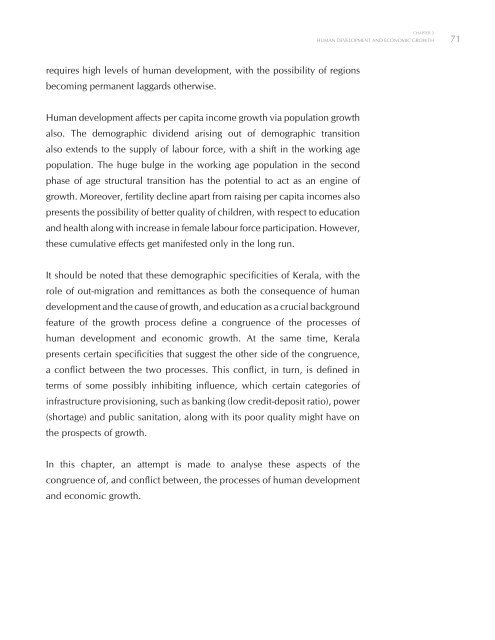Kerala 2005 - of Planning Commission
Kerala 2005 - of Planning Commission
Kerala 2005 - of Planning Commission
Create successful ePaper yourself
Turn your PDF publications into a flip-book with our unique Google optimized e-Paper software.
CHAPTER 5<br />
HUMAN DEVELOPMENT AND ECONOMIC GROWTH<br />
71<br />
requires high levels <strong>of</strong> human development, with the possibility <strong>of</strong> regions<br />
becoming permanent laggards otherwise.<br />
Human development affects per capita income growth via population growth<br />
also. The demographic dividend arising out <strong>of</strong> demographic transition<br />
also extends to the supply <strong>of</strong> labour force, with a shift in the working age<br />
population. The huge bulge in the working age population in the second<br />
phase <strong>of</strong> age structural transition has the potential to act as an engine <strong>of</strong><br />
growth. Moreover, fertility decline apart from raising per capita incomes also<br />
presents the possibility <strong>of</strong> better quality <strong>of</strong> children, with respect to education<br />
and health along with increase in female labour force participation. However,<br />
these cumulative effects get manifested only in the long run.<br />
It should be noted that these demographic specificities <strong>of</strong> <strong>Kerala</strong>, with the<br />
role <strong>of</strong> out-migration and remittances as both the consequence <strong>of</strong> human<br />
development and the cause <strong>of</strong> growth, and education as a crucial background<br />
feature <strong>of</strong> the growth process define a congruence <strong>of</strong> the processes <strong>of</strong><br />
human development and economic growth. At the same time, <strong>Kerala</strong><br />
presents certain specificities that suggest the other side <strong>of</strong> the congruence,<br />
a conflict between the two processes. This conflict, in turn, is defined in<br />
terms <strong>of</strong> some possibly inhibiting influence, which certain categories <strong>of</strong><br />
infrastructure provisioning, such as banking (low credit-deposit ratio), power<br />
(shortage) and public sanitation, along with its poor quality might have on<br />
the prospects <strong>of</strong> growth.<br />
In this chapter, an attempt is made to analyse these aspects <strong>of</strong> the<br />
congruence <strong>of</strong>, and conflict between, the processes <strong>of</strong> human development<br />
and economic growth.

















